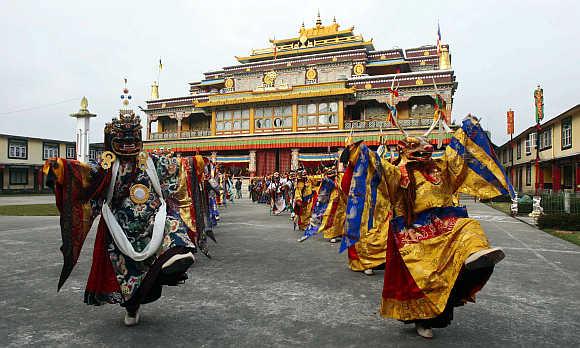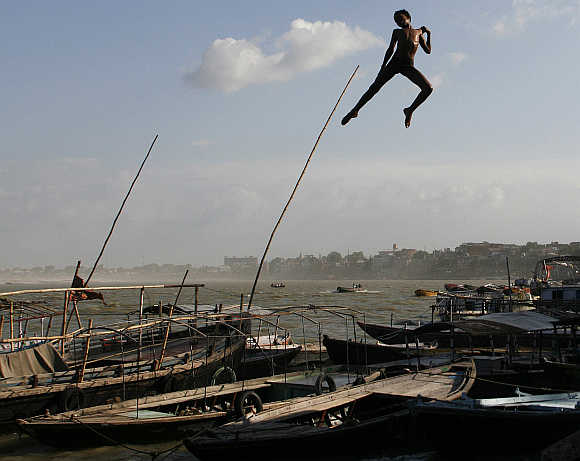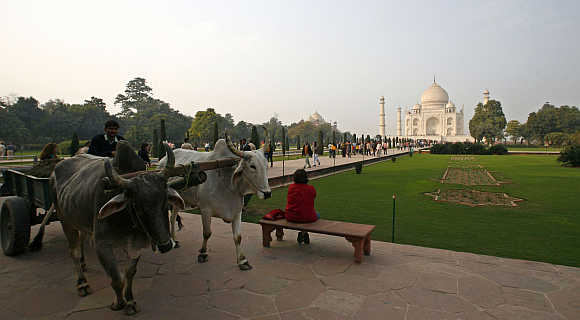 | « Back to article | Print this article |
'Energy revolution is America's big comeback story'
How many of us travel with $25 billion in our luggage?
Ruchir Sharma, head of the emerging markets equity team at Morgan Stanley Investment Management, New York, certainly does. An economic traveller, he hops from country to country, uncompromisingly sniffing out opportunity, for Morgan Stanley's billions. Every week he may be in a different country, figuring out its economic climate, testing its investment waters.
Like a detective, he has to quickly and astutely construct a picture of the financial scene of a nation, based on any clue he picks up - a stray remark by a taxi driver, the prices in his hotel, a careless comment by a politician and more. And make an informed investment decision on the country.
Last year, Sharma, a native of Jaipur, a graduate of Delhi's Shri Ram College of Commerce, decided to write a book about his travels. Breakout Nations: In Pursuit of the Next Economic Miracles was a bestseller.
A few weeks ago, Sharma, the author and investment banker, was in India to attend the Jaipur literature festival. He was in conversation with Nandan Nilekani, chairman of the Unique Identification Authority of India, about his book.
India Abroad's Vaihayasi Pande Daniel listened in. This is the final part of a three-part feature. First and second parts are here and here.
Nandan Nilekani: Let's just go back to this commodity boom. You said there was a cycle of ten years of boom and 20 years of bust. This commodity boom began about 10 years back, so are we not entering the reverse of the cycle. Are we now going to see a downturn in commodities?
Ruchir Sharma: I think signs of that are already emerging. Many commodity prices have been doing quite poorly. And I think even in some key commodities, such as oil, we are finding that new discoveries are taking place. This is America's very big comeback story - the energy revolution that is taking place out there. A lot of new investments are coming up. A lot of new technology is coming up to try and get new sources of energy.
To me, the fact that the commodity super cycle is coming to an end is a very good thing. This is once again going to get investment flowing in the right areas. Rather than suck up too much in the wrong areas.
Nilekani: It will help India right? India is a big commodity consumer, so it will help us. And reduce this cronyism too?
Sharma: Yes, I think so. I think one of the big positives for India in the coming decade could be lower commodity prices.
Nilekani: We have talked about the US. And one of the big stories in the US, in the last five years, has been the extraordinary growth in new energy sources, thanks to innovations in gas drilling etc. The US has been the source in great innovations in technology. So do you now see the US as the new big emerging market?
Sharma: In the new chapter, I am coming out with in the book, for the epilogue, I have extended this argument of Breakout Nations to the developed world. If I were to pick a Breakout Nation in the developed world I would pick out America. I think the US is staging some sort of renaissance. I think it is happening in manufacturing. I think in energy.
Here is the most important statistic: One third of the total spend on research and development in the world is done in America. One third. So they really remain on the cutting edge. All the cutting edge technology that comes from Apple, Google, still comes out of the West Coast in America.
Other countries are able to imitate and copy, but the origin of a lot of this new source of innovation still comes out from the US because of the amount they spend on research and development.
Click NEXT to read more...
'Energy revolution is America's big comeback story'
Nilekani: You manage $25 billion in emerging markets. You can't spend that money in America. Somebody else will do that. So what happens to all the money? Do you have other winners? In your travels, are there other hot spots that you like, that you think will be big in the coming decade?
Sharma: That is the good thing about emerging markets. They cover 80 per cent of the world's population. There is always some rising star and always (someone fading) out there. In the book I have come out with a series of countries that could be Breakout Nations over the next five years or so.
I speak about countries in Southeast Asia, like the Philippines. I speak about Indonesia, Thailand. I speak about countries such as Turkey, Eastern Europe and in Africa countries such as Nigeria. So to me these are the new stars that are emerging. And many of them are emerging because they did quite poorly over the last decade or two. That's the natural cycle over the last decade or two.
Your backs are to the wall. You have an incentive to reform. You do very well for a decade or two. You fritter the gains away. You know what is the interesting thing about India in this context? Over the last 30 to 40 years India has followed a very nice 10-year cycle - which is every 10 years we have some sort of macro economic crisis. That usually sets the stage for the next advance to begin.
I think last year was some sort of mini macro-crisis in India where the rupee seemed to be falling out of bed. The rating agencies were under downgrade. And you see a lot of reforms take place in India from September onwards. In 1991 something similar happened. In 1980 something similar happened.
Both those times we went to the IMF to sort of seek assistance and we carried out reforms on the back of the assistance we sought. In 2001 we also carried out a lot of reforms after the bust in the technology sector and India's growth rate really fell down to three or four percent in 2001-2002. I think that's the whole point. Every 10 years you get some sort of reform cycle that takes place.
So India to me - in the book I am a bit (lukewarm) about India. I think it is 50:50, the chances of being a Breakout Nation. But I think the signs are improving, at least at the margin, because of these factors over the last year.
Click NEXT to read more...
'Energy revolution is America's big comeback story'
Nilekani: You were talking about the rupee. How big is the currency stuff in all this? Overvalued currencies, undervalued currencies: How do you make sense of all that?
Sharma: It is a bit counter-intuitive. But here is my Rule of the Road, which I think is easy to (follow). One of the privileges I have is that whenever we travel to one of these emerging markets, we get to stay in very good hotels. One of the indexes I have created in the book is the Four Seasons Index.
If you go to any emerging market the benchmark hotel to stay in is the Four Seasons or the equivalent and you see what the room rate is. If the room rate is really cheap, you know this place is competitive. If it is really expensive, you know this place is really expensive and it is not that competitive.
For example, if you go today to Brazil or Russia, and you want to stay in one of the fancy rooms in Rio facing the Ipanema Beach, or you want to stay in Moscow near the Red Square, you are paying up to a $1,000 a night for a room in those countries! And you know that is a problem for these countries.
You go to a place like Thailand, Indonesia, the Philippines and at the same hotel equivalent of the Four Seasons, you are paying $200 to $300 dollars a night. To me, that really tells me about the fact that you need cheap currency.
So in India one of the mistakes we made was that our currency really got expensive and uncompetitive. But the fact that the rupee has fallen, I know is not a great sign for many people. It is a loss of confidence. But I think the rupee has corrected.
It has made India more competitive and we need a weaker exchange rate not one out of crisis, but a genuinely undervalued exchange rate to do well at this per capita income level.
Nilekani: We talked about some of the changes - The commodity cycle is coming to an end. Easy money will continue because the West will continue to pump easy money. You talk about the fact that US has cheap energy and the US has done a lot of things on robotics and (easy) manufacturing so that manufacturing may actually move back to the US from China and elsewhere.
Similarly, there is a lot of service automation going on, with all this clouds and so on. So services could be moving back. So what does this mean for emerging markets that grow on commodity prices, outsourcing and off shoring. Is there a fundamental change happening in these areas?
Sharma: The competition is just getting tougher. Apart from the US, the other place where value is really emerging is Europe. Again, this sounds very counter-intuitive. Europe is a very big mess today, but it is really cheap.
You go to Spain, Italy, these countries' labour costs have fallen and a lot of competitiveness has come back. So the competition is much more intense in these countries. It is going to be a lot more difficult to compete with these countries, so that's a big change.
Click NEXT to read more...
'Energy revolution is America's big comeback story'
The second thing is that emerging markets are so big in size - about 70 to 80 per cent of the global population. So some new stars will keep emerging. The good news is that these commodity-exporting countries may not do that well, but commodity-importing countries may do quite well. So there is a change in leadership taking place in emerging markets.
But I say in the book, in the closing line, that when there is no wind, row. The tail wind you had over the last decade of easy money and the fact that the West was willing to invest a lot in emerging markets and those economies were in relative decline. Now that trend is showing signs of turning around and now the competition becomes more intense.
Nilekani: You said India was 50:50. Ram Guha (the historian Ramchandra Guha) said the same thing. Where do you see India? You have been an India watcher for over 20 years. You have seen the whole world come back here. Lots of the things you have said may be prescient.
How do you see the future?
Sharma: I think, as far as India is concerned, this is one country I have genuinely been conflicted about. Maybe it is because I am too close to the situation. With other countries I can have a more dispassionate view. You go to a Brazil, you go to a Russia, and you see them more dispassionately. On the margins, things have improved because expectations have come off.
In India's case, the last decade was all about eight, nine percent, spread sheets out, extrapolate this endlessly into the future. Expectations had come off. That eight, nine talk has today that has gone out the window. Now we are talking about six percent. Expectations coming off has been a very good thing as far as India is concerned.
And the fact that we are reforming, back to the wall. The new chief ministers, that are emerging in India's states, are much more competent, compared to a decade ago. I think in India the model is changing. The old model of India's growth was a very centralized model, top down from Delhi. This is emerging more like an ideal like Europe, which is a collection of states.
Each (Indian) state is much more autonomous and much more different. And we are finding that more successful chief ministers are getting elected, on the back of a development platform. One statistic today: There are six chief ministers in this country today that have won an election three times or more. Two decades ago, apart from one chief minister in a state called West Bengal, no other chief minister was able to win more than two elections.
Many other states are re-electing their leaders on a positive development platform and that was not happening in this country two to three decades ago. So that is the big change which has taken place in India. And to me that is the single biggest source of optimism I have on India. The centralised-Delhi-national-controlled model is in decline.
Click NEXT to read more...
'Energy revolution is America's big comeback story'
Nilekani: If you had to name three or four reforms that need to get done in India, what would you suggest?
Sharma: The culture of welfare-ism. I am not against it. But you can only write checks which your exchequer can cash. We need to have a sort of control on our spending habits because we have lost discipline on our habits in the last decade or so. That is once thing that is very important.
The second thing is to create a more level playing field, so you have new entrepreneurs arise. You want more churn on the billionaire list, new people to come up there. I just think we need much more discipline in this country.
Look at inflation. Look at how we have lost the plot here. If you look at the rankings of inflation, for decades India used to be in the middle of the rankings. But in the last three years, of the 180 economies in the world, India's inflation ranking is 150, 160. That's a shocking statistic. That's the kind of stuff you need to get back in control for this country to be on track again.
Nilekani: Overall are you optimistic, pessimistic, realistic?
Sharma: 50:-50. You know the other thing I have learned about writing a book. No matter how global you are, the first thing people want to know is what is he or she saying about my country?
I learned this lesson the hard way. The last literature fest I spoke at was in Edinburgh. I gave my global spiel, like I am doing with you here. The first question from the audience was: Do you think Scotland can be a Breakout Nation? I never thought about that. But it taught me that when you go to a place, be as local as possible.
So as far as India's concerned I have learnt the same thing. I wrote the book. I wrote about the world. But the first thing that people want to know – India. What is the view on India? It is interesting how sentiments have shifted.
When the book first came out, the popular reaction in the press was that you are being too pessimistic by saying it is 50:50. By August last year the reaction was you are being too optimistic by giving India a 50 percent chance.
I think it is a better time now. But I still feel it is a long slog ahead. It is definitely a better time to be investing today than it was a year ago, especially not when the exporter's son was telling me: Where else will the money go?
Nilekani: I think you should call him up now and check his mood...




